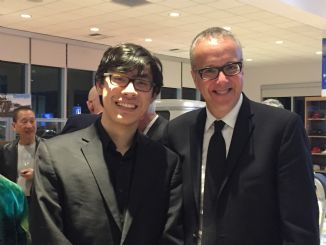|
Symphony
MONUMENTAL MAHLER 5TH IN SO CO PHIL'S SEASON ENDING CONCERT
by Terry McNeill
Sunday, April 14, 2024
Chamber
OAKMONT SEASON CLOSES WITH STRAUSS' PASSIONATE SONATA
by Terry McNeill
Thursday, April 11, 2024
Chamber
MORE GOLD THAN KORN AT ALEXANDER SQ CONCERT
by Terry McNeill
Sunday, April 7, 2024
Choral and Vocal
VIBRANT GOOD FRIDAY REQUIEM AT CHURCH OF THE ROSES
by Pamela Hicks Gailey
Friday, March 29, 2024
TWO OLD, TWO NEW AT THE SR SYMPHONY'S MARCH CONCERT IN WEILL
by Peter Lert
Saturday, March 23, 2024
Chamber
NOT A SEVENTH BUT A FIRST AT SPRING LAKE VILLAGE CONCERT
by Terry McNeill
Wednesday, March 20, 2024
THIRTY-THREE PLUS VARIATIONS AND AN OCEAN VIEW
by Terry McNeill
Saturday, March 16, 2024
Choral and Vocal
A ST. JOHN PASSION FOR THE AGES
by Abby Wasserman
Friday, March 8, 2024
Choral and Vocal
SPLENDID SCHUBERT SONGS IN SANET ALLEN RECITAL
by Terry McNeill
Saturday, March 2, 2024
Chamber
SHAW'S MICROFICTIONS HIGHLIGHTS MIRO QUARTET'S SEBASTOPOL CONCERT
by Peter Lert
Friday, March 1, 2024
|
 |
 Cellist Zlatomir Fung (l) and Conductor Marc Taddei Jan. 29 |
FUNG TRIUMPHS IN SHOSTAKOVICH CONCERTO WITH VSO
by Elizabeth Warnimont
Sunday, January 29, 2017
The Vallejo Symphony Orchestra presented their season’s second concert Jan. 29 in Vallejo’s Hogan Auditorium, devoted to early Haydn, middle Shostakovich and Beethoven’s ground-breaking “Eroica” Symphony.
In remarks to the audiences of nearly 400, Conductor Marc Taddei characterized Haydn’s Symphony No. 7 in C Major (“Noon”) as a work of raw talent, written before the classical-era master developed his more mature and refined, signature composition style. The piece is built on a simple, even structure, with distinct variations on a brief melodic themes. Here there is much repetition in rhythm and melody, though surprisingly the piece lacks power and even variation in mood.
Part of a triptych of Haydn Symphonies (the season’s first concert featured the “Morning” Symphony, with the “Evening” to come in March) the work began with a beautiful mixture of winds and strings, setting a mood of pleasantness and contentment, full of color in its balanced blend of sound. As the movement got rolling those segments of sonic harmony and clear phrasing from the horns with well-synchronized strings became only intermittent.
The more emotional second (adagio) movement sounded frothy and in one sense refreshing in its bright innocence. Mr. Taddei drew a masterful performance from the VSO, highlighting the youthful work’s complexity in the concluding menuetto and allegro movements, with standout playing from double bassist Andy McCorkle. Wind playing seems timid in the former, but Bonnie Lockett’s piccolo playing in the latter was exemplary. Mr. Taddei chose a quick tempo in the finale that was exciting.
Shostakovich’s Cello Concerto No. 1, Op. 107, began simply with a four-note theme from solo cellist Vlatomir Fung, and the theme was quickly taken up by the string sections and built to considerable pulsating power, The conductor controlled the frenetic pace of there second moderato movement, a sharp contrast to the steady rhythms of the opening allegretto movement. The playing in this exciting part was soothed by music from bassoonist Karla Ekholm, juxtaposed by the urgency of the solo part and the bass and cello section playing. Here Mr. Fung’s bow control in the demanding solo part was masterful. At this point the music, with continuous second, third and fourth movements, turns to long periods of slow quiet. Even the timpani began to sound overly muted. A startling punctuation by chimes contributed to this dreamy mood, as the cello phrases spanned the from the instrument’s highest to its lowest registers, but so gently as to maximize the dreamy feel.
The Concerto, written in 1959, concluded with an allegro where both the orchestra and Mr. Fung increased volume but strangely not their passion. Seven powerful notes from timpanist John Weeks preceded the ending and fulsome audience applause.
Mr. Taddei has in the past spoken of Beethoven’s E-Flat Major Symphony, the third, as “the most important symphony ever written.” From a historical perspective, the Op. 55 work has manifold innovations and is said to reflect the ideals of the French Revolution that occurred more than15 years prior to the first public performance in 1805. Mr. Taddei’s interpretation caught the grandeur and heroism of the opening allegro con brio and the two forceful E Flat Chords. String playing was quickly dominant along with energetic wind playing. In the following adagio the mournful Marcia Funebre seemed too brief and inconspicuous, but in the scherzo the flute section lent a joyous and confident sonority, sounding wonderful from the critic’s seat left of center orchestra. Here in the allegro finale the violin playing, lead by concertmaster Joyce Lee, was potently elegant.
The VSO’s next program will be March 12 in Hogan, and will feature Haydn’s Symphony No. 8, Kabalevsky’s Violin Concerto (Kay Stern, soloist) and Tchaikovsky’s epochal last Symphony, No. 6, in B in Minor (“Pathétique”).
|

